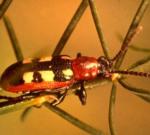Asparagus, problems
-
Rust caused by the fungus Puccinia asparagi

Asparagus rust is characterized by different color spots or pustules on spears and fern branches. Orange pustules are present on new spears in spring and brick red pustules develop on stalks, branches, and leaves in summer. Black spores are present in fall and winter. Fern yellowing and browning, defoliation, and dieback may occur.
Rust is favored by temperatures between 55° and 90° F. Several hours of dew or rain are necessary for spores to germinate and infect the host. Rust is most common on fern growth after the harvest season is over. Infections begin in spring from spores that overwintered on crop debris. As ferns mature and die, the black-spore stage may develop. These black spores are the overwintering stage of the fungus. Read more about the fungus life cycle.
Solutions
Rust is most prevalent in more humid areas. Provide adequate irrigation during the spring and summer fern period so that the plants are neither over- or underwatered. Sulfur and other fungicides applied when rust first occurs are helpful in control. Cut down diseased ferns at the crown and destroy. Resistant varieties may be available.
Asparagus beetles
The asparagus beetle, Crioceris asparagi, can be found in California gardens. The larvae are dark green-gray grubs about 0.75 inch (9 mm) long when full grown. The adults are bluish-black beetles with red and yellow markings.
Damage
Adults of the asparagus beetle chew the growing tips of spears in spring leaving brown stains, scars, or blemishes. Larvae may chew ferns, causing them to appear bleached. Read more about the beetle life cycle.
Solutions
Remove spears promptly. Handpick beetles or wash eggs, larvae, and adult beetles off with a strong stream of water. Clean up debris and remove and destroy ferns by proper pruning in late fall to reduce overwintering sites for adults. Avoid insecticides because of potential harm to parasites and predators, and damage is not usually serious enough to warrant it. Applications of a pyrethrin spray may be effective against larvae when they are young.
Read more about problems growing asparagus.


